Disease on plants usually starts out at a low level, a small number of plants affected and a small amount of plant tissue affected, and it becomes of concern to us only when its incidence and severity increases with time. When we look at some examples of plant disease epidemics from the published literature, we not only notice that the incidence or severity starts near zero and then increases dramatically, but we also can discern some distinct patterns of development with time. For example, in Phytophthora blight of pepper seedlings (
) of maize, disease progress is roughly linear (allowing for some minor deviations that we can consider random error).
|
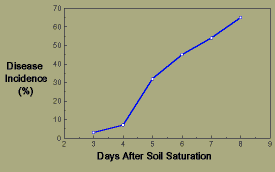
Phytophthora blight of pepper seedlings
|
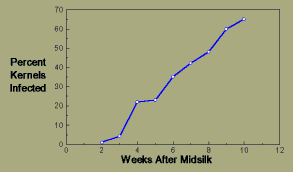
Fusarium kernel rot of maize
|
On the other hand, in bean rust (Uromyces phaseoli) and grey leaf spot of corn (Cercospora zeae-maydis), there is a definite upward curve; that is, disease increases at an increasing rate, a curve we could call exponential.
|
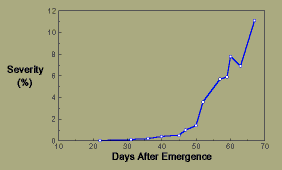
Bean rust
|
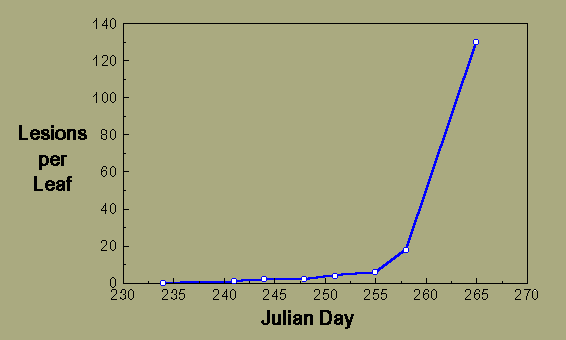
Grey leafspot of maize
|
Obviously plant disease cannot continue to increase forever, and as the level of disease approaches 100%, the disease progress curve gradually flattens out. For example, in epidemics such as the infection of beans by Sclerotium rolfsii or the infection of tobacco by Phytophthora nicotianae, disease progress starts out looking linear but slows down as it approaches a maximum.
|
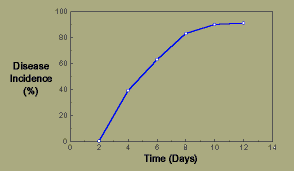
Sclerotium rolfsii on beans
|
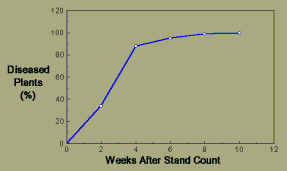
Black shank on tobacco
|
Likewise, the disease progress curves of Puccinia graminis subsp. graminicola on ryegrass and Pyrenophora teres f. sp. teres on barley appear exponential at first, but as time goes on and the incidence and severity of disease approach 100%, the rate of disease progress gradually slows to zero, giving both curves a somewhat sigmoid shape ("S" shape).
|
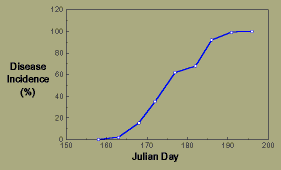
Black stem rust on ryegrass
|
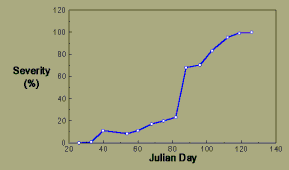
Net blotch on barley
|
To be sure, not all examples of disease progress can be as neatly categorized as these, but in general plant disease epidemics tend to be either roughly linear or exponential in the early stages, and they tend to level off as they approach some limit.
The impact of plant disease and the losses that it causes are a function of disease progress. To reduce this impact, we need not eliminate the disease, we merely need to keep disease development below an acceptable level. That means that the progress of disease and the factors that influence disease progress must be understood in quantitative terms. We have to know what kinds of diseases lead to linear disease progress and what factors affect the slope of the line (the rate of disease progress). Likewise, we have to know what kinds of diseases tend to produce exponential disease progress curves and how we can reduce both the starting level of disease and the rate of epidemic development. Finally, we have to know why epidemics sometimes level off and what imposes limits to their development.
The Cyclical Nature of Plant Disease
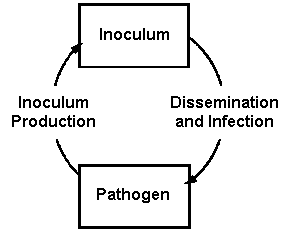
Plant disease epidemics are cyclical phenomena, that is, they consist of repeated cycles of pathogen development in relation to the host and the environment. The inoculum, which might consist of fungal spores, bacterial cells, nematodes, viruses within an aphid vector, or some other propagules of a pathogen, gains entry into and establishment within the host tissues through the process of infection. The pathogen develops within the host and eventually begins to produce new inoculum, which, in turn, can be dispersed to new susceptible sites to initiate new infections. Pathogens that produce only one cycle of development (one infection cycle) per crop cycle are called monocyclic, while pathogens that produce more than one infection cycle per crop cycle are called polycyclic. Generally in temperate climates there is only one crop cycle per year, so the terms "monocyclic" and "polycyclic" are based on the number of cycles per year. In tropical or subtropical climates, however, there can be more than one crop cycle per year, and it is important to remember that "monocyclic" and "polycyclic" are based on a single crop cycle. These same terms are used to describe the epidemics as well as the pathogens, so we often speak of a "monocyclic epidemic" or a "polycyclic epidemic".
For some diseases it is important to consider an epidemic over a period of many growing seasons. This is particularly true for perennial plants (forages, pastures, lawns, orchards, forests, etc.) or for annual crops that are grown in monoculture year after year. In these situations the inoculum produced in one growing season carries over to the next, and there could actually be a buildup of inoculum over a period of years. In the tropics there may not be clear-cut breaks between growing seasons such as we find in the temperate zones, and epidemics can be virtually continuous over periods of many years on such crops as bananas, coffee, and rubber trees. We refer to these epidemics as polyetic epidemics, regardless of whether the pathogen is monocyclic or polycyclic within each season.
|
The Dutch elm disease is an example of a monocyclic pathogen giving rise to a polyetic epidemic. Note that while there is only one cycle of infection each year and disease progress within each year is roughly linear, the incidence of infected trees increases at an increasing rate from year to year. |
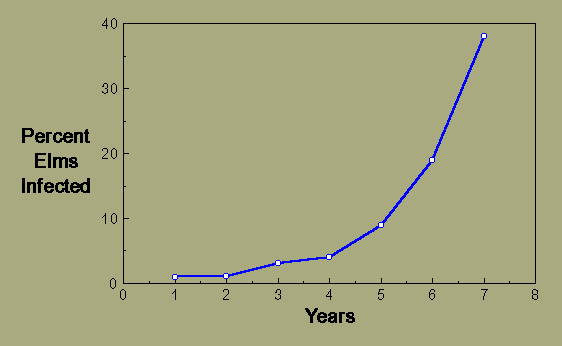 |
|
Apple powdery mildew is an example of a polyetic epidemic caused by a polycyclic pathogen. Note how the incidence of infection at the start of each year tends to increase exponentially.
|
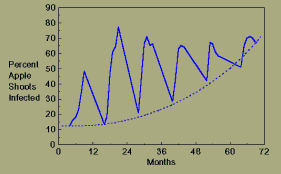 |
|
Sigatoka leaf spot on bananas decreases somewhat during the dry season but otherwise produces more or less continuously repeated cycles of infection. The host, in this case, consists of a population of plants of different ages developing continuously over a long period of time. |
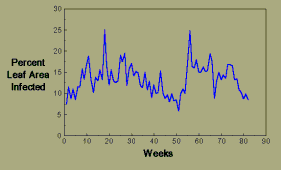 |
Relating Disease Progress to Disease Cycles
If we analyze the disease cycles of the epidemics for which we have plotted disease progress, we see that the epidemics that progress roughly linearly or are linear at the start tend to be monocyclic epidemics. On the other hand, the diseases that increase at an increasing rate during the early part of the epidemic tend to be polycyclic epidemics.
Monocyclic Epidemics
In general, there are three types of plant diseases that tend to produce only one infection cycle per host cycle (1) postharvest diseases, (2) diseases caused by soil-borne plant pathogens, and (3) rusts without a urediniospore stage.
Postharvest DiseasesNot all postharvest diseases produce monocyclic epidemics, but in many cases the infections that result in storage rots have either already occurred before harvest or occur during the harvest and postharvest handling before the product goes into storage. The rot progresses during storage, and new inoculum may be continuously produced, but unless the stored product is handled again to disperse the inoculum and create new infection sites by making small wounds, there are no new infection cycles. Note that the pathogen is not inherently monocyclic but is constrained by the environment to produce only a single cycle of infection. In other environments, these same pathogens might produce polycyclic epidemics.
|
Brown Rot of Peach
|
|
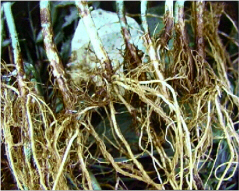
Fusarium root rot of bean
|
Diseases Caused by Soilborne Plant Pathogens.
Many of the root rots, vascular wilts, and other diseases caused by soilborne pathogens also produce only one infection cycle per crop cycle. The inoculum generally is some kind of survival structure resistant to desiccation or freezing, such as sclerotia, chlamydospores, or oospores in the soil or mycelium in crop residues. This inoculum is dispersed in the soil by plowing and fitting the land and turning under the crop residues. As the roots of the newly planted crop grow through the soil, they encounter the propagules of the pathogen embedded in the soil matrix and become infected. The epidemic progresses as new infections occur, but since any new inoculum that is produced is not dispersed until the soil is again cultivated, there is only one complete infection cycle per cropping cycle. To be sure, not all soilborne plant pathogens produce monocyclic epidemics, and one must be very careful to understand the life cycle of each pathogen before drawing conclusions about its epidemiology.
Demicyclic rusts.
Some rusts produce no urediniospore stage (repeating stage) on a single host, and the inoculum produced on one host species generally must infect a different host species. This alternation of hosts appears to have evolved in adaptation to the annual growth cycles of the hosts, and we see one infection cycle on each host per year. An example is the cedar-apple rust, where all the inoculum that infects apples comes from galls on red cedars (junipers), and all the inoculum that infects red cedars comes from apple leaves and fruit. The epidemic on apples occurs during a four- to six-week period of basidiospore production in the spring. A second monocyclic epidemic on red cedars occurs during a brief period of aeciospore production in late summer. |
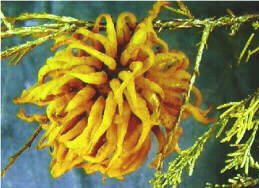
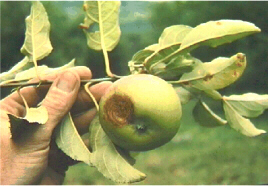
|
| Cedar-Apple Rust
|
Polycyclic Epidemics
|
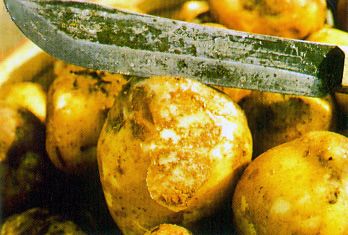
Late blight of potato
|
In order for an epidemic to be considered polycyclic, there must be repeated complete infection cycles, that is, infection followed by pathogen development, new inoculum production, dispersal to new susceptible sites, and new infections, all within a single crop cycle. A good example is potato late blight, where a single cycle of infection, lesion development, sporulation, sporangium dispersal, and new infection can occur in as little as five days, and many overlapping cycles occur simultaneously during periods of favorable weather.
|
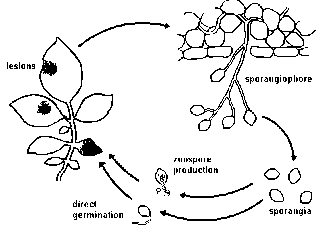
Late blight disease cycle
|
Each cycle can produce more than a ten-fold increase in numbers of sporangia landing on susceptible sites, and an explosive epidemic results. Cereal rusts behave similarly; a single urediniospore can infect to produce a pustule from which hundreds of new urediniospores can be released to infect and produce hundreds of new pustules repeatedly throughout the season. Most plant diseases caused by bacteria are polycyclic, and many plant viruses, with the aid of their insect vectors, also can produce repeated cycles of infection in one season.
Combinations of Monocyclic and Polycyclic Epidemics
Not every plant disease epidemic is clearly either monocyclic or polycyclic. Epidemics produced by fungi with two spore stages can have elements of both, sometimes in distinct phases, and sometimes occurring simultaneously. For example, the fungus Venturia inaequalis, causal agent of apple scab, produces ascospores on the dead, infected leaves that have overwintered from the previous season. These ascospores are released over a period of six to eight weeks in the spring and infect the newly expanding apple leaves. Since no new ascospores are produced until the following spring, this component of the epidemic might be considered monocyclic. However, each leaf lesion within about ten days produces a second type of spores, conidia, that also can infect newly expanding leaves. Thus, for the early part of the season, a polycyclic epidemic is superimposed on a monocyclic epidemic. Since lesions produced by conidia cannot be distinguished from those produced by ascospores, the net effect appears to be a rapidly growing polycyclic epidemic.
|
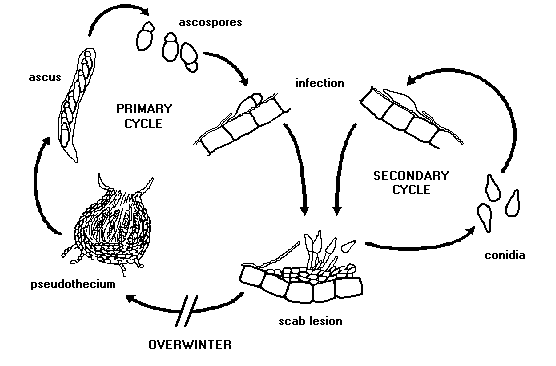
Apple scab disease cycle |
An epidemic of tan spot on wheat, caused by Pyrenophora tritici-repentis, also comprises both polycyclic and monocyclic elements. The initial inoculum occurs on infected seed, and the epidemic starts as these seeds germinate to yield seedlings bearing leaf lesions. Conidia are disseminated by wind and splashing rain in repeated cycles of leaf infection throughout the period of crop development (the polycyclic phase). By the time flowering begins, the inoculum for the second phase of the epidemic has built up on the upper leaves of the plant, principally the flag leaf. The flowers and developing grains are susceptible for a relatively brief period to infection by the inoculum extant at the time of flowering, and the lesions on the glumes of the developing grains do not produce inoculum capable of infecting more grains. Seed infection, therefore, is a monocyclic phenomenon. It is these infected seeds that provide a major means of carryover of this pathogen from one crop to the next and the initial inoculum for the new crop.\
|
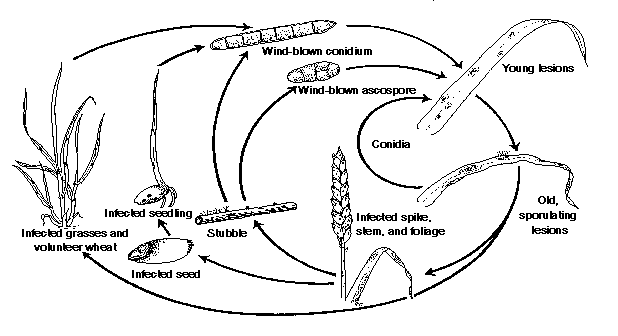
Tan spot disease cycle
|
Next: Mathematical Models
